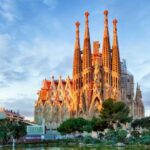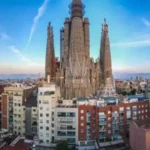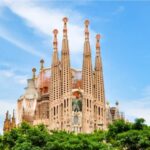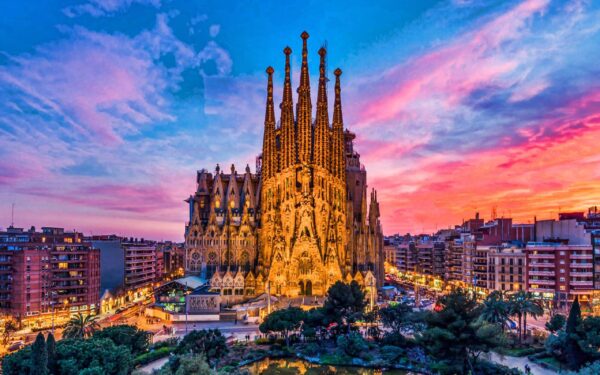
Barcelona, a city renowned for its stunning architecture and vibrant culture, is home to one of the most captivating structures in the world: La Sagrada Familia. This masterpiece, designed by the visionary Antoni Gaudí, combines intricate artistry with profound spirituality, leaving visitors in awe of its grandeur and detail.
In this article, we delve into The Enigmatic Beauty of La Sagrada Familia: Exploring Barcelona's Iconic Landmark, uncovering the layers of meaning behind its elaborate façades and soaring towers. From its ambitious construction to its place in the heart of Catalonia, La Sagrada Familia stands as a testament to human creativity and devotion, inviting all who encounter it to reflect on its stunning beauty.
The Architectural Marvels of La Sagrada Familia: A Journey Through Gaudí's Vision
The architectural marvels of La Sagrada Familia extend far beyond its impressive façade. Gaudí's vision was to create a structure that harmoniously blends with nature, achieving this through organic forms and vibrant colors. The use of hyperboloid shapes and parabolic arches not only enhances structural integrity but also evokes the natural world. Each element serves a dual purpose of aesthetic beauty and functional design, creating a unique experience for every visitor.
One of the most striking features of La Sagrada Familia is its intricate symbolism. Gaudí embedded religious motifs and natural elements within the architecture. For instance, the façades depict scenes from the life of Christ, while the columns in the interior resemble tree trunks, reaching toward the heavens. This connection to nature is not just visual; it is integral to the overall spiritual experience of the basilica.
Visitors can embark on a journey through the various stages of Gaudí's design process, each reflecting his evolving thoughts and inspirations. The Nativity Facade, with its detailed sculptures, celebrates the birth of Christ, while the Passion Facade conveys sacrifice and suffering. These contrasting themes showcase Gaudí’s ability to tell a profound story through architecture, drawing the observer into a deep emotional engagement.
In summary, La Sagrada Familia invites us to explore a fusion of art, faith, and nature. Its architectural innovations, such as the use of light and shadow through stained glass windows, create an ethereal atmosphere that captivates all who enter. As the basilica continues to evolve, it remains a living testament to Gaudí's extraordinary vision and an enduring symbol of Barcelona's artistic heritage.
Unveiling the Spiritual Significance of La Sagrada Familia: More Than Just a Cathedral
La Sagrada Familia is more than just a stunning architectural feat; it serves as a profound spiritual sanctuary for countless visitors. The basilica embodies the essence of Christian faith, reflected in its intricate designs and symbolic representations. Each aspect of Gaudí's creation invites contemplation, encouraging individuals to connect with deeper spiritual truths and the divine.
One of the most compelling elements of La Sagrada Familia is its integrative symbolism. Gaudí purposely designed the structure to reflect key aspects of Christianity, including the Holy Trinity. Each tower signifies an essential figure in the faith: the tallest one represents Jesus Christ, the two others symbolize the Virgin Mary and the apostles, creating a sacred hierarchy within the architectural space. This deliberate arrangement fosters a sense of reverence among visitors.
Additionally, the use of natural light throughout the basilica plays a crucial role in the spiritual experience. The vibrant stained glass windows transform sunlight into a kaleidoscope of colors, evoking a sense of divine presence. As visitors walk through the interiors, they can feel the interplay of light and shadow, which enhances the emotional depth of the environment, making the space feel alive and spiritually charged.
In essence, La Sagrada Familia transcends its physical form to become a living testament of faith, creativity, and community. As construction continues, each new addition not only showcases Gaudí's vision but also signifies the ongoing journey of spiritual discovery for all who enter. This remarkable landmark invites everyone to reflect on their own beliefs and the beauty of creation, making it a truly unique and immersive experience.
Exploring the Intricate Details of La Sagrada Familia: A Closer Look at Its Facades
The façades of La Sagrada Familia are a remarkable reflection of Antoni Gaudí's artistic genius, each telling a unique story through its intricate details. The Nativity Facade is adorned with vibrant sculptures that celebrate the birth of Jesus, showcasing a plethora of natural forms and biblical figures. In contrast, the Passion Facade presents a stark, angular design, symbolizing the suffering and sacrifice of Christ. This duality not only highlights Gaudí's versatility but also deepens the viewer's emotional engagement with the narratives presented.
Upon closer inspection, visitors will discover an array of exquisite details embedded in the façades. These include:
- Religious Motifs: Each façade incorporates key Christian symbols, such as the cross and the Holy Family.
- Natural Elements: Stone carvings of flora and fauna connect the basilica to the surrounding landscape.
- Architectural Innovations: The use of hyperboloids and parabolic arches adds structural strength while enhancing aesthetic appeal.
Furthermore, Gaudí's meticulous attention to craftsmanship is evident in the textures and materials used throughout the façades. Each stone, carved with precision, contributes to the overall narrative, inviting visitors to ponder the spiritual significance behind the artistry. The dynamic interplay between light and shadow across the surfaces emphasizes these features, creating an ever-changing visual experience as the sun moves throughout the day.
In conclusion, exploring the façades of La Sagrada Familia not only reveals Gaudí's architectural mastery but also offers a profound insight into his spiritual vision. As one stands before these magnificent walls, it becomes clear that they are not merely structural elements, but a celebration of faith, nature, and human creativity, inviting all to reflect on their own spiritual journeys.
The History Behind La Sagrada Familia: From Construction Beginnings to Present Day
The history of La Sagrada Familia is as intricate as its stunning architecture. The basilica's construction began in 1882, driven by architect Francisco de Paula del Villar. However, it was Antoni Gaudí who took over the project a year later, infusing it with his unique vision. His commitment to the basilica's design not only influenced its architectural direction but also set the stage for a monumental journey that would span over a century.
Gaudí's approach to La Sagrada Familia was revolutionary; he envisioned a structure that would embody both nature and spirituality. His designs were heavily inspired by the natural world, incorporating elements that mimic forms found in nature, such as trees, flowers, and even rocks. This profound connection led to the creation of intricate details that tell biblical stories and represent religious symbolism, turning the basilica into a living testament to faith.
As construction progressed, the project faced numerous challenges, including funding shortages and the upheaval of the Spanish Civil War. Despite these obstacles, Gaudí's innovative methods and passionate dedication kept the vision alive. Today, La Sagrada Familia is still under construction, with an expected completion date in the late 2020s. The ongoing work reflects both the original intent of Gaudí and the advancements in technology that allow for more intricate designs.
Currently, La Sagrada Familia attracts millions of visitors each year, making it one of Barcelona's most iconic landmarks. The basilica's ongoing evolution not only serves as a testament to Gaudí's genius but also highlights the importance of preserving cultural heritage in a rapidly changing world. Each stone laid is a step forward in a journey that began over a century ago, inviting future generations to experience its beauty and spirituality.
How La Sagrada Familia Became a UNESCO World Heritage Site: Cultural Importance Explained
La Sagrada Familia was designated a UNESCO World Heritage Site in 2005, recognized for its exceptional cultural significance and architectural beauty. This honor underscores the basilica's unique ability to encapsulate the spirit of Catalan modernism through its innovative use of form and structure. Gaudí's design approaches not only redefine traditional architecture but also reflect a deep spiritual narrative that resonates with visitors from around the globe.
One of the key factors contributing to its UNESCO status is the basilica's integrative symbolism. La Sagrada Familia embodies a fusion of religious and natural elements, represented through its intricate facades and interior designs. This seamless blend highlights the cultural importance of the site, as it serves as both a religious monument and an artistic expression of faith that transcends mere functionality.
Moreover, the ongoing construction of La Sagrada Familia signifies a living cultural heritage. UNESCO emphasizes the importance of sites that not only represent historical significance but also actively engage with contemporary society. The basilica's continuous evolution reflects the commitment to preserving Gaudí's vision while adapting to modern techniques and needs, making it a dynamic symbol of cultural continuity.
In summary, La Sagrada Familia's recognition as a UNESCO World Heritage Site is a testament to its role as an architectural marvel and a cultural beacon. It highlights the intersection of art, faith, and community, inviting visitors to explore its profound beauty and underlying messages. This landmark not only represents the brilliance of Antoni Gaudí but also stands as a crucial part of Barcelona's identity and cultural legacy.
Visiting La Sagrada Familia: Tips for an Unforgettable Experience in Barcelona
Visiting La Sagrada Familia is an unforgettable experience, and planning your journey can enhance your appreciation of this architectural wonder. To make the most of your visit, consider arriving early in the morning to avoid the largest crowds. This quiet time allows for a more serene exploration of the basilica, where you can fully immerse yourself in its intricate details.
Before you go, be sure to book your tickets online in advance. This not only saves you time but also guarantees your entry on your desired date. Additionally, consider choosing a guided tour to gain deeper insights into Gaudí's vision and the basilica's rich history. Here are a few tips to ensure a memorable visit:
- Respect the sacred space: La Sagrada Familia is a place of worship, so maintain a respectful demeanor.
- Dress appropriately: Ensure your attire is modest and suitable for a religious site.
- Bring a camera: Capture the stunning details, but remember to be mindful of other visitors.
As you explore the interior, take time to marvel at the breathtaking stained glass windows that bathe the space in a kaleidoscope of colors. The interplay of light and shadow not only enhances the spiritual atmosphere but also showcases Gaudí's unique understanding of natural elements and their significance. Don't forget to look up; the towering columns resemble trees, further connecting visitors to the beauty of nature.
Lastly, be aware that La Sagrada Familia is still under construction, with updates and changes occurring regularly. This ongoing journey of creation adds an exciting layer to your visit, as you witness history in the making. Embrace the opportunity to engage with this living symbol of Barcelona, where art, faith, and culture intertwine seamlessly.
 The Fascinating Facts You Need to Know About La Sagrada Familia in Barcelona
The Fascinating Facts You Need to Know About La Sagrada Familia in Barcelona Unveiling the Beauty: The Sagrada Familia in Barcelona - A Finished Masterpiece
Unveiling the Beauty: The Sagrada Familia in Barcelona - A Finished Masterpiece The Extravagant Beauty of Sagrada Familia in Barcelona: Essential Information
The Extravagant Beauty of Sagrada Familia in Barcelona: Essential InformationIf you want to know other articles similar to The Enigmatic Beauty of La Sagrada Familia: Exploring Barcelona's Iconic Landmark you can visit the category WHERE YOU CAN GO.
Leave a Reply










Read more!